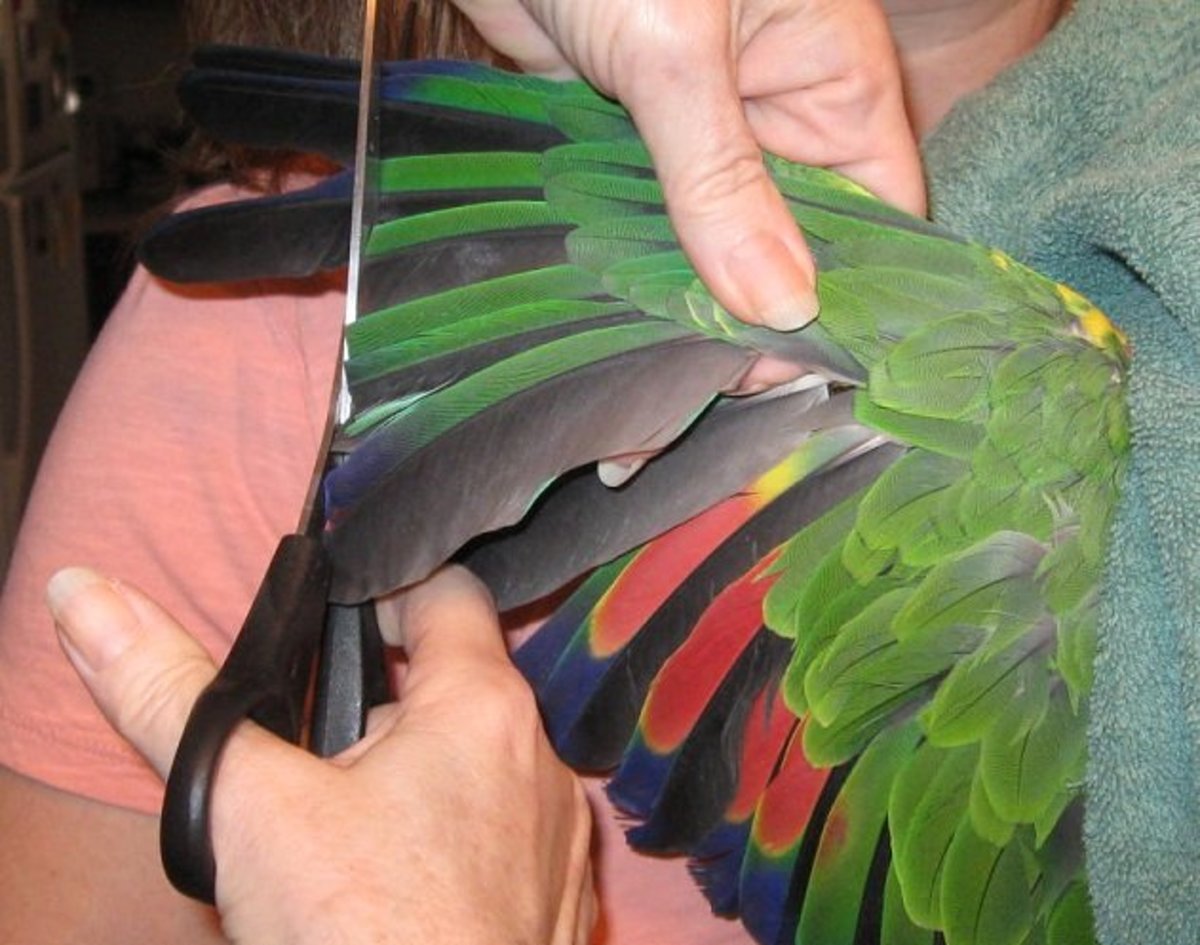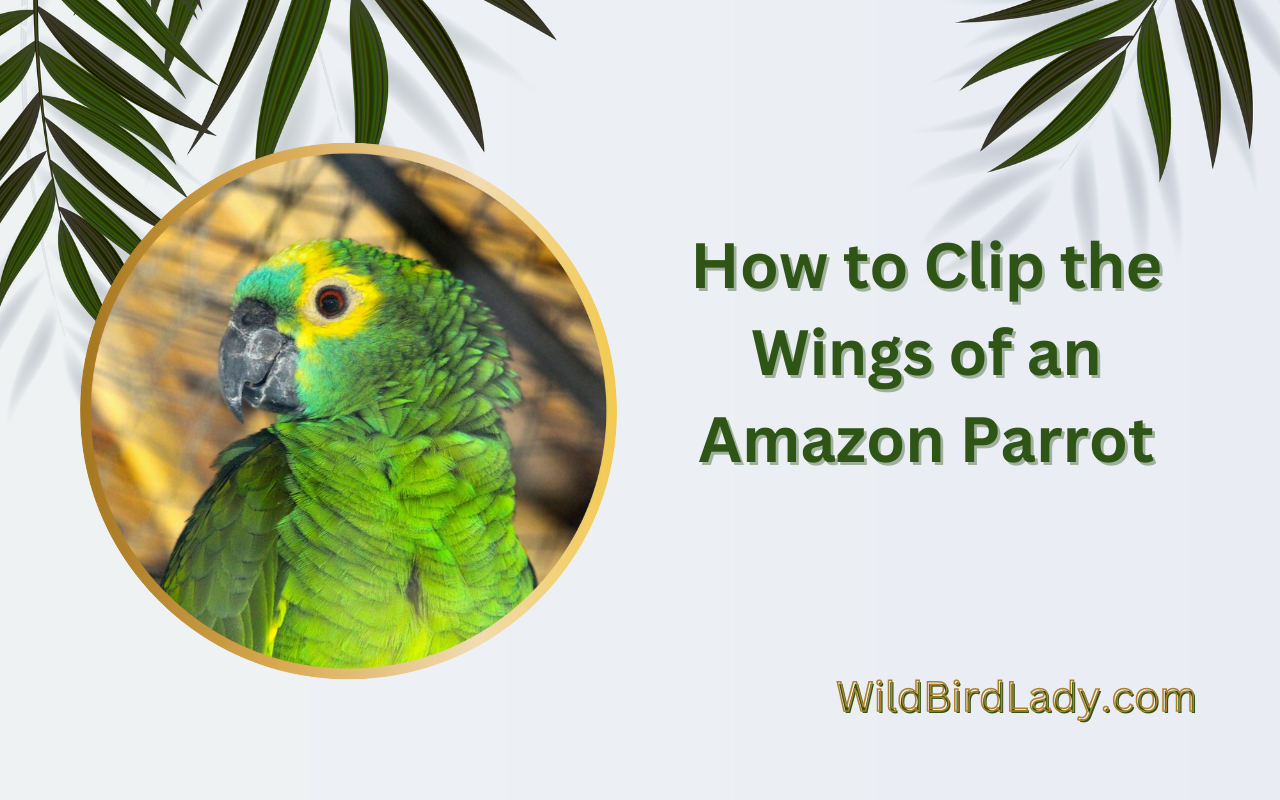To clip the wings of an amazon parrot, you will need to restrain the bird gently and carefully trim the primary flight feathers on each wing. Clipping is a necessary process for bird owners to prevent their pets from flying away or getting injured.
Are you a proud owner of an Amazon parrot? These intelligent and affectionate birds make fantastic companions, but they can sometimes exhibit challenging behavior like attempting to fly away. That’s where wing clipping comes in! Clipping the wings of your Amazon parrot is a safe and temporary procedure that prevents them from flying off or getting into harmful situations.
But why should you consider clipping your parrot’s wings? Not only does it safeguard them from potential dangers, but it also helps with behavior issues by limiting their ability to misbehave. And here’s the best part: wing clipping doesn’t cause any pain or long-term harm to your beloved bird.
In this article, we’ll cover everything you need to know, from understanding your parrot’s wing anatomy to gathering the essential tools and materials. We’ll provide a foolproof step-by-step guide, along with crucial aftercare tips to ensure a smooth transition for your feathered companion. So, let’s embark on this feathered adventure together and discover the art of safely clipping the wings of an Amazon parrot!

Credit: pethelpful.com
Understanding Amazon Parrots
Amazon parrots are one of the most intelligent and entertaining parrot breeds, often displaying their vocal abilities and charming personalities. If you’re considering getting an amazon parrot or already own one, it’s essential to understand their unique characteristics and the reasons why clipping their wings is necessary.
Why Clipping Their Wings Is Necessary
- Clipping their wings is essential for their safety as it prevents them from flying into any harmful objects or situations.
- It also encourages their independence, allowing them to move around the house without the fear of injury.
- Clipping their wings can help with behavior problems, as it limits their ability to misbehave and ensures they stay put in their cage when necessary.
- It is a temporary procedure and doesn’t cause any pain or long-term damage to the bird.
Understanding amazon parrots’ unique characteristics is crucial to providing them with the proper care and attention they need. Clipping their wings is a necessary and safe procedure that ensures their safety and well-being, giving you peace of mind and a happy, healthy bird.
Tools and Materials Required
Clipping the wings of an amazon parrot is a necessary part of owning and caring for one of these intelligent and beautiful birds. When undertaking this process, it’s important to have the right tools and materials. Not only do you need items that are suitable for the task at hand, but they must also be of good quality and sterilized to ensure the safety of your bird.
Here’s a rundown of the required tools and materials to gather before beginning this process:
List Necessary Tools and Materials Before Starting The Process
- Stainless steel bird scissors – sharp and strong scissors that are specifically designed for cutting bird feathers. Using dull or rusty scissors can be harmful and painful for your bird.
- Towel – a towel will come in handy for wrapping your bird, providing a soft surface for them to sit, and protecting them during the process.
- Styptic powder – in the event that you accidentally cut a blood feather, styptic powder can be a lifesaver. It quickly stops bleeding by thickening blood and forming a clot.
- Rubbing alcohol – before and after using the scissors, rub them with rubbing alcohol to sterilize them.
- Flashlight – a small flashlight can help you locate the blood feathers, as they may be harder to spot on darker feathers.
Explain the Importance of Ensuring That They Are of Good Quality and Sterilized
The quality of the tools and materials used for wing clipping is crucial for your bird’s safety and well-being. Any damage or poor-quality items can lead to injury or infection. It’s also essential to sterilize the tools before and after use to eliminate any potential harmful bacteria or pathogens.
Using high-quality, sterilized tools and materials will prevent the spread of disease, ensure that your bird is comfortable, and make the process more efficient.
Now that you have all of the necessary tools and materials, it’s time to learn how to successfully clip your bird’s wings. With a little bit of patience and some guidance, you’ll be able to safely and humanely clip the wings of your amazon parrot.
The Clipping Process
Clipping the wings of an amazon parrot may seem daunting at first, but with the right tools and a bit of understanding, it can be easily accomplished. Here’s what you need to know about the clipping process.
Understanding The Anatomy Of The Wings Before Starting The Process
Before beginning the process, it’s essential to understand the parrot’s wings’ anatomy. The primary feathers of the wing (also known as flight feathers) are the longest, and clipping them will prevent the parrot from achieving full flight. However, cutting too many feathers can cause problems with balance and mobility.
Step-By-Step Guide
Here’s a step-by-step guide on how to clip the wings of an amazon parrot-
- Gather the tools required for the process- nail clippers or other trimming scissors, and styptic powder.
- Distract the bird and make it feel comfortable before beginning. A treat will help!
- Use your fingers to locate the primary feathers of the bird’s wings. They are the longest feathers and easily recognizable.
- Begin by trimming the first ten primary feathers of the bird’s wings. Cut them halfway down the feather shaft.
- Check the wings to adjust the feathers if needed. Some birds may require fewer feathers to be clipped, depending on their weight and size.
- If the bird starts to bleed, use styptic powder to stop bleeding.
- Let the bird rest before returning it to its cage.
Remember that wing clipping should be done every three to four months to maintain its effectiveness. It’s always better to seek professional assistance when necessary for beginners.
Clipping the wings of your amazon parrot takes time, patience, and understanding. Follow this step-by-step guide and keep in mind the bird’s well-being during the process.
Aftercare and Tips
Clipping the wings of an amazon parrot is a crucial procedure that requires great care to ensure the bird’s safety and comfort. After the procedure, proper aftercare and monitoring are necessary to avoid any complications. Here are some essential tips and aftercare routines to follow:
How To Monitor The Bird’s Behavior After The Procedure
To ensure the comfort and well-being of the bird after wing-clipping, monitor its behavior closely. Here are some signs to watch for:
- The bird should be alert, responsive and able to perch. If you notice any unusual behavior such as lethargy or reluctance to perch, take the bird to a vet immediately.
- Check if the bird is eating and drinking. The bird should be consuming the same amount of food and water as usual. If not, it might be a sign of stress or discomfort.
- Watch for signs of stress such as excessive panting, breathing heavily or abnormal vocalization.
Outline The Essential Post-Clipping Aftercare Routine
Aftercare routine is essential to ensure the bird’s comfort and well-being:
- To prevent infection, clean the bird’s wings with antiseptic lotion or spray. Make sure not to touch the feathers, as it can be painful for the bird.
- Watch for signs of bleeding or swelling. Apply a styptic powder or cornstarch if bleeding occurs.
- Keep the bird in a quiet and peaceful environment for at least a few hours after the procedure. Avoid handling the bird during this time.
- Provide adequate food and water, as usual.
- Do not allow the bird to bathe or get wet for at least 24 hours after the procedure.
- Make sure to avoid any exercise that involves using wings, such as flying or climbing, for at least a few days.
- Observe the bird for any signs of discomfort or pain. If you notice anything unusual, take the bird to a vet immediately.
Clipping the wings of an amazon parrot is a delicate procedure that requires great care and attention. Proper aftercare and close monitoring are essential to ensure the bird’s comfort and well-being. By following these aftercare routines and tips, you can keep your bird healthy and happy for years to come.
Frequently Asked Questions
How Often Should You Clip The Wings Of Your Amazon Parrot?
You should clip your amazon parrot’s wings every three to four months, or as needed. Clipping the wings more frequently can lead to stress and discomfort.
What Tools Do You Need To Safely Clip Your Amazon Parrot’s Wings?
The tools you will need are a pair of bird nail clippers, a towel or perch to restrain your bird, and a styptic powder to stop any bleeding.
Can Clipping Wings Hurt An Amazon Parrot?
Clipping wings does not cause any permanent damage to an amazon parrot, but improper clipping can lead to discomfort, injury, or stress. Done correctly, clipping helps prevent accidents and keep your bird safe.
How Do You Know When To Clip Your Amazon Parrot’s Wings?
It’s time to clip your parrot’s wings when you notice they’re flying into objects or getting into dangerous situations. Observe their behavior and consider the size of your home or aviary to determine when to clip their wings.
Should You Have A Professional Clip Your Amazon Parrot’s Wings?
If you’re a new bird owner or unsure how to clip your amazon parrot’s wings, it’s best to have a professional do it for you. An expert can also show you how to do it yourself so you can save time and money in the future.
Conclusion
Clipping the wings of your amazon parrot is a crucial step in ensuring their safety and well-being. As an owner, it is your responsibility to take necessary measures to prevent any potential dangers, including flying into danger or harm’s way.
With the proper techniques and guidance, you can successfully clip your bird’s wings without causing them any pain or discomfort. However, it is important to remember that this is a temporary solution and should not be relied on as a permanent fix.
Monitoring your bird, providing adequate flight opportunities, and investing in training are all crucial steps in maintaining a happy and healthy parrot. By implementing these strategies and taking a conscientious approach to bird care, your amazon parrot can thrive in their environment, while also keeping them safe and secure.
Latest Posts
The Ultimate List: Top 8 Best Birdwatching Podcasts for Avid Birders
Looking for the top birdwatching podcasts? Here are the eight best options to tune into today! Birdwatching can be a thrilling, immersive experience that brings...
Stop Squirrels in Their Tracks: 10 Effective Ways to Safeguard Your Bird Feeder Pole
To prevent squirrels from climbing your bird feeder pole, use squirrel baffles and slippery poles. Here are ten effective ways to keep squirrels from stealing bird food and damaging bird feeders. ...


